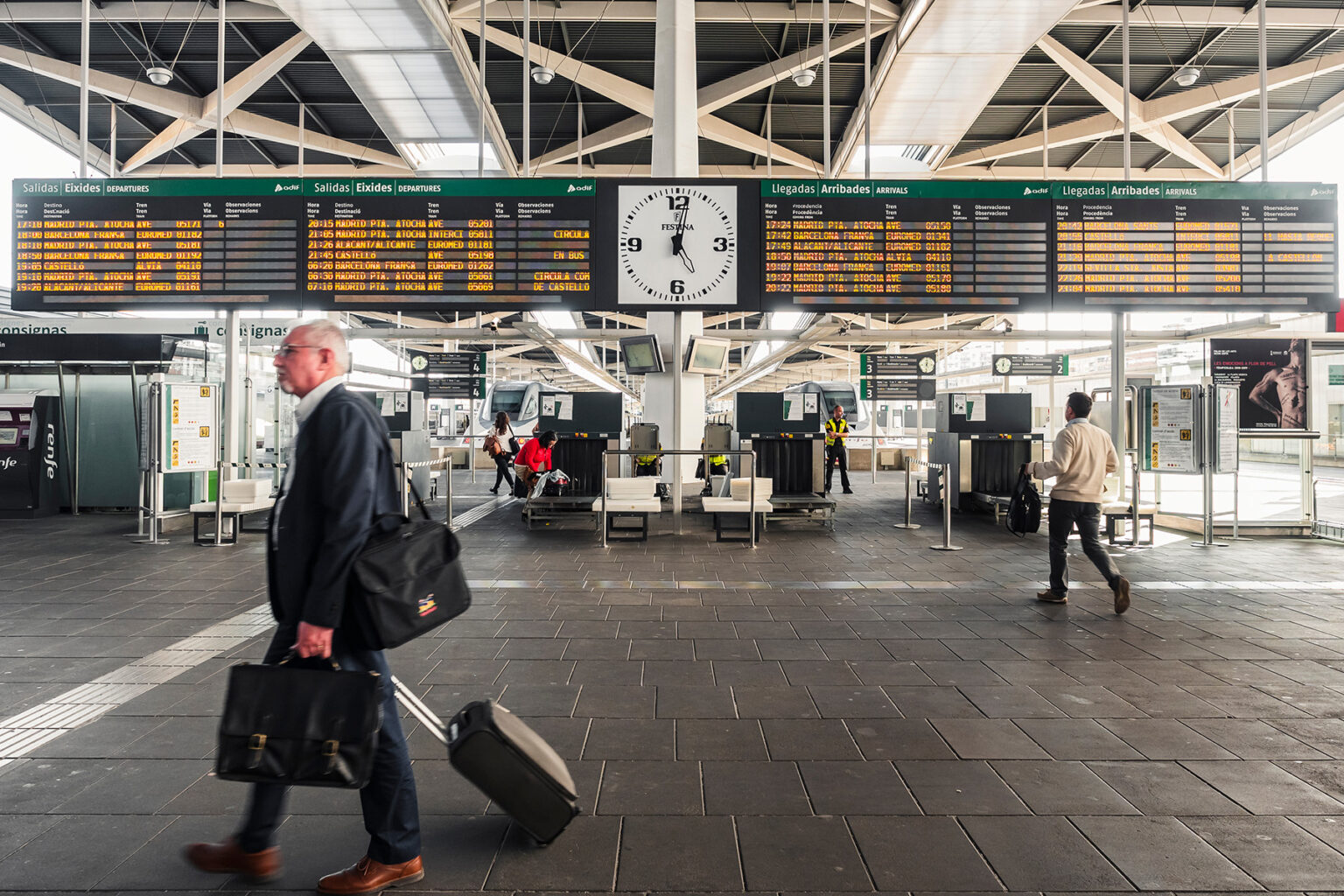The country is full of big cities with big-city public transport systems, so there are plenty of reasons to leave your car at home. With metro networks, buses, and an impressive number of trains, getting around the city or even across the country is simple.
Here are some important topics to get you started:
- Public transport in Spain
- Public transport apps in Spain
- Trains in Spain
- Buses in Spain
- Taxis and ride-sharing services in Spain
- Long-distance coaches in Spain
- Airports in Spain
- Other methods of public transport in Spain
- Public transport discounts in Spain
- How disability-accessible is public transportation in Spain?
- How environmentally friendly is public transportation in Spain?
- Making a public transport complaint in Spain
- Useful resources
Omio
Want to fly away from it all? Or maybe you're looking for a family adventure by train? Wherever you're going, Omio can help you find the best deals for your journey. This one-stop shop lets you compare a range of transport modes, explore new destinations, and buy tickets at the touch of a button. Wherever adventure takes you, get there with Omio.
Public transport in Spain
Who needs a car, anyway? Spain’s public transport options have made plenty of headway in recent decades, from building Europe’s longest high-speed rail network to light rail running through dozens of cities. The amount of people commuting by car in Spain is comparable to the EU average, but cities like Madrid are approaching a majority when it comes to public transport use.
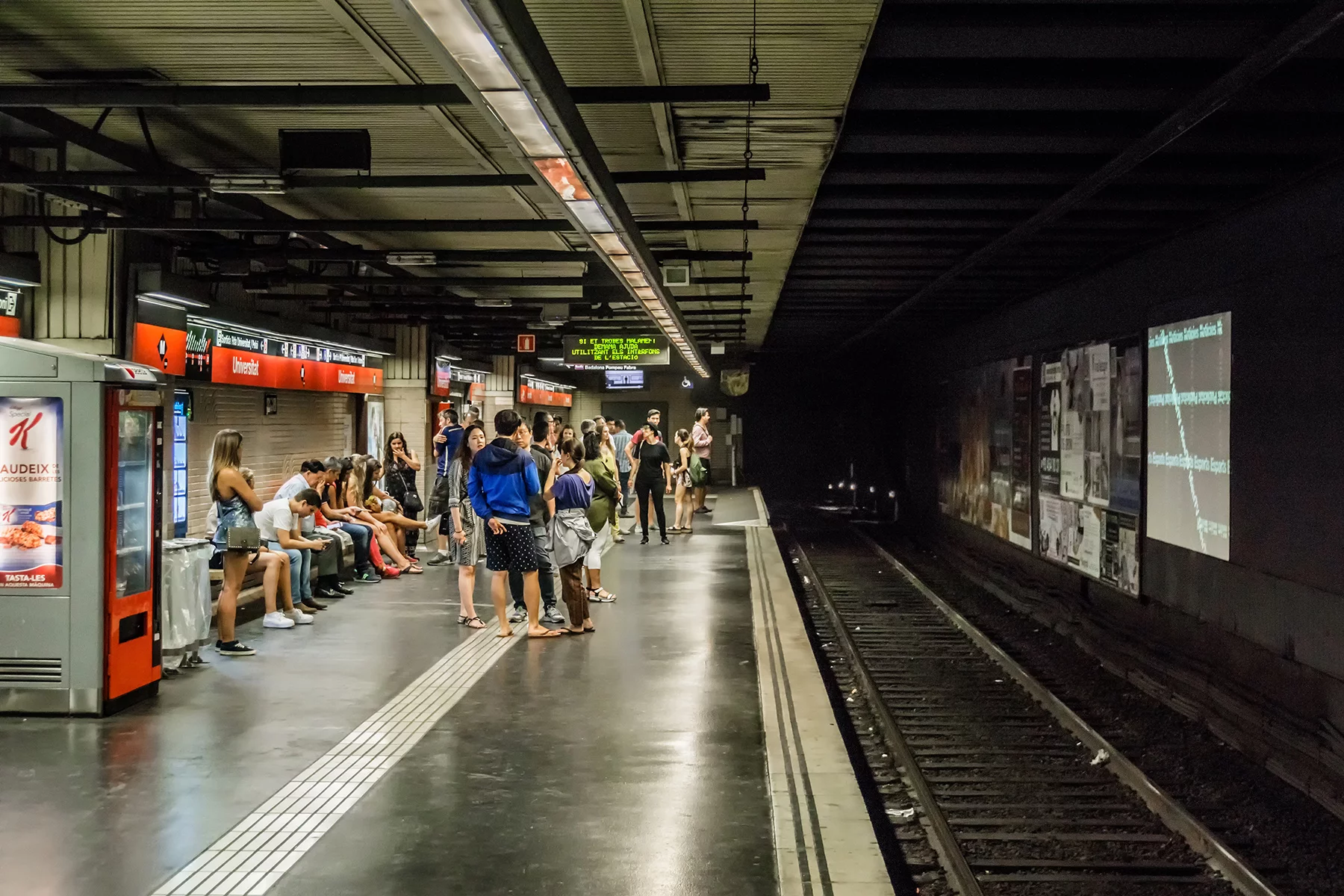
Taking public transport is a great alternative to driving in Spain and it’s generally quite safe for most passengers. Crime levels aboard trains are quite low, especially at stations where security checks are in place. There is, however, one exception to this: pickpocketing. As a major tourist destination, large public transport hubs in Spain tend to have quite a few pickpockets targeting hapless tourists. Be especially mindful of your surroundings and belongings in areas with a lot of tourists, such as busy train stations and buses in Barcelona and Madrid.
Public transport infrastructure in Spain (especially when it comes to trains) tends to be quite modern, though there is a clear divide between the wealthier regions and the rest. That said, change is on the horizon. While Spain has lacked a national financing mechanism for public transport, a recent draft law (in Spanish) aims to finance and promote sustainable mobility. Due to Spain’s lagging investment in country-wide transport, national travel cards, which are widespread in many countries such as Japan’s Pasmo and Suica cards and the Dutch OV-chipkaart, haven’t caught on just yet.
Public transport apps in Spain
Journey-planning apps abound for travelers in Spain. A few of the more popular options include:
- Citymapper is available in several Spanish cities. The app is available for Android, iOS, and in your browser.
- Google Maps covers almost every country on the planet and Spain is no different. Most public transport networks in Spain sync their route information to Google Maps, so it’s ideal for planning a trip on the fly. Google Maps is available for Android, iOS, and also in your browser.
Spain’s national railway company, Renfe, has a wide collection of apps for travelers. The most useful ones are:
- Renfe Ticket: The core app for traveling with Renfe, Renfe Ticket lets users search for itineraries, book trips, and use their tickets from their phone. Renfe Ticket is available for Android and iOS.
- Cercanías: An app specifically for regional train travelers in Asturias, Barcelona, Bilbao, Cádiz, Madrid, Málaga, Murcia, Santander, San Sebastián, Sevilla, Valencia, and Zaragoza. Cercanías has network maps, timetables, and ticket purchases. The app is available for Android and iOS.
If you’re taking a long-distance bus instead, some companies have an app of their own, including:
Trains in Spain
Spain’s railway network is one of the busiest in Europe. According to the International Union of Railways annual report, 328 million passengers traveled over 11 billion kilometers on 15,847 kilometers of tracks in 2020, making Spain one of the most well-used rail networks. Considering Spain’s poor cross-border connections, that’s an astonishing level of domestic travel.
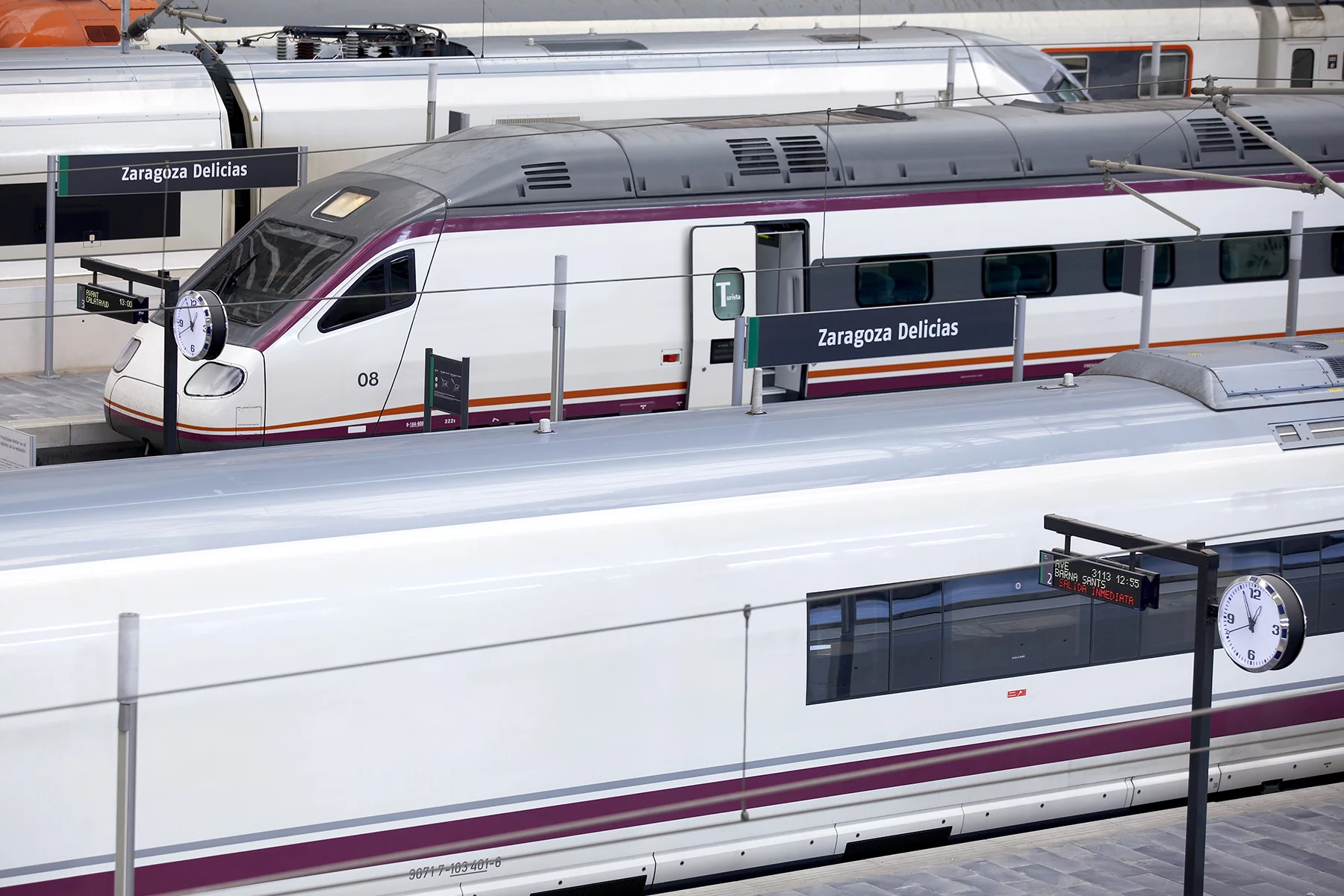
Renfe is Spain’s national rail company, carrying over 510 million passengers annually. In fact, Spain is home to one of the world’s largest high-speed rail networks, second only to China. Trains on the high-speed rail network travel at speeds up to 310km/h; only Spain’s northernmost autonomous communities (such as Cantabria and the Basque Country) as well as Extremadura and Murcia lack high-speed connections. Ambitious expansions will connect every autonomous community in Peninsular Spain by 2023.
Spain also has regional train companies, including:
- Euskotren Trena: Euskotren Trena operates metro networks and commuter rail lines in the Basque Country.
- Ferrocarril de Sóller (FS): FS runs historical wooden trains along a single line on Mallorca, connecting Palma and Sóller.
- Ferrocarrils de la Generalitat de Catalunya (FGC): FGC operates commuter rail in and around Barcelona, some mountain railways, and four funiculars.
Some French trains also enter Spain, such as SNCF’s high-speed trains (TGV) and regional trains (TER).
Distinguishing between the different trains in Spain is confusing for newcomers, as Renfe often brands regional networks and individual routes. In general, there are three types of train services in Spain:
- Larga Distancia (long-distance): These services include high-speed services like AVE or intercity services that partially use high-speed routes (e.g., Alvia, Altaria, Intercity).
- Media Distancia (medium-distance): Services at this level travel between urban areas but are the second-fastest option.
- Local services: These services include Regional Express trains. Local services often stop at every station.
Train tickets in Spain
Ticketing for Spanish trains was once comically complex, but Renfe has at least simplified the fares on offer. Seat reservations are mandatory for the majority of trains in Spain with some exceptions for local routes. Fare classes with Renfe are as follows:
- Básico (basic): Standard ticket with added costs for extras such as seat selection, pets, and changes and cancellations.
- Elige (pick & mix): Standard or comfort ticket with discounts for missed trains, changes, and cancellations. Seat selection, pets, refreshments, and extra seats for a smaller charge than the Básico ticket.
- Prémium (premium): Comfort ticket with free seat selection, ticket-holder change, changes and cancellations, missed trains, pets, and refreshments. 30% discount on extra seats.

Spanish trains usually have two classes: standard (second-class) and comfort (first-class). On high-speed lines, comfort passengers receive a hot meal and access to Sala Club lounges at the departure station.
Renfe usually opens ticket reservations either 90 days (for AVE trains) or 60 days (for all others) before departure. This isn’t always the case, however; some trains are only available with as little as a month to spare.
Tickets are available directly on the Renfe website. It’s possible to book tickets in English, French, and a variety of Spain’s regional languages.
Train timetables and maps in Spain
Renfe doesn’t offer a fully downloadable timetable for its network, but there is a searchable online timetable. There are also national network maps for long-distance high-speed services as well as medium-distance routes.
Timetables and network maps are also available from Catalonia’s FGC and Mallorca’s FS. Euskotren provides downloadable timetables and maps, too.
Spanish train stations
Similar to other European countries, railway infrastructure in Spain is separate from the train services themselves. While Renfe operates most of the trains, ADIF (Administrador de Infraestructuras Ferroviarias) looks after the tracks and over 2,000 train stations.
ADIF provides extensive information about Spanish train stations on their website, including live departures, in-station services, shops, dining, and onward public transportation connections. Larger train stations tend to have paid toilets, luggage storage, and ticketing desks. Spanish train stations tend to have cafés and restaurants as opposed to a wealth of takeaway options; think of it as a chance to soak in the brilliant design of Madrid Atocha’s botanical garden.

Keep in mind that security checkpoints are common in the busier Spanish train stations. Err on the side of caution and don’t assume that getting to the station three minutes before departure will have a good end result.
Urban and regional trains in Spain
With dozens of cities having more than 200,000 residents, Spain has a great need for big public transport networks. To that end, there are dozens of rapid transit operators across the country.
Spain has 12 commuter rail networks:
- Asturias: Cercanías Asturias
- Catalonia: Rodalies de Catalunya
- Bilbao: Cercanías Bilbao/Bilboko Aldiriak
- Cádiz: Cercanías Cádiz
- Madrid: Cercanías Madrid
- Málaga: Cercanías Málaga
- Murcia/Alicante: Cercanías Murcia/Alicante
- Santander: Cercanías Santander
- San Sebastián: Cercanías San Sebastián
- Sevilla: Cercanías Sevilla
- Valencia: Cercanías Valencia
- Zaragoza: Cercanías Zaragoza
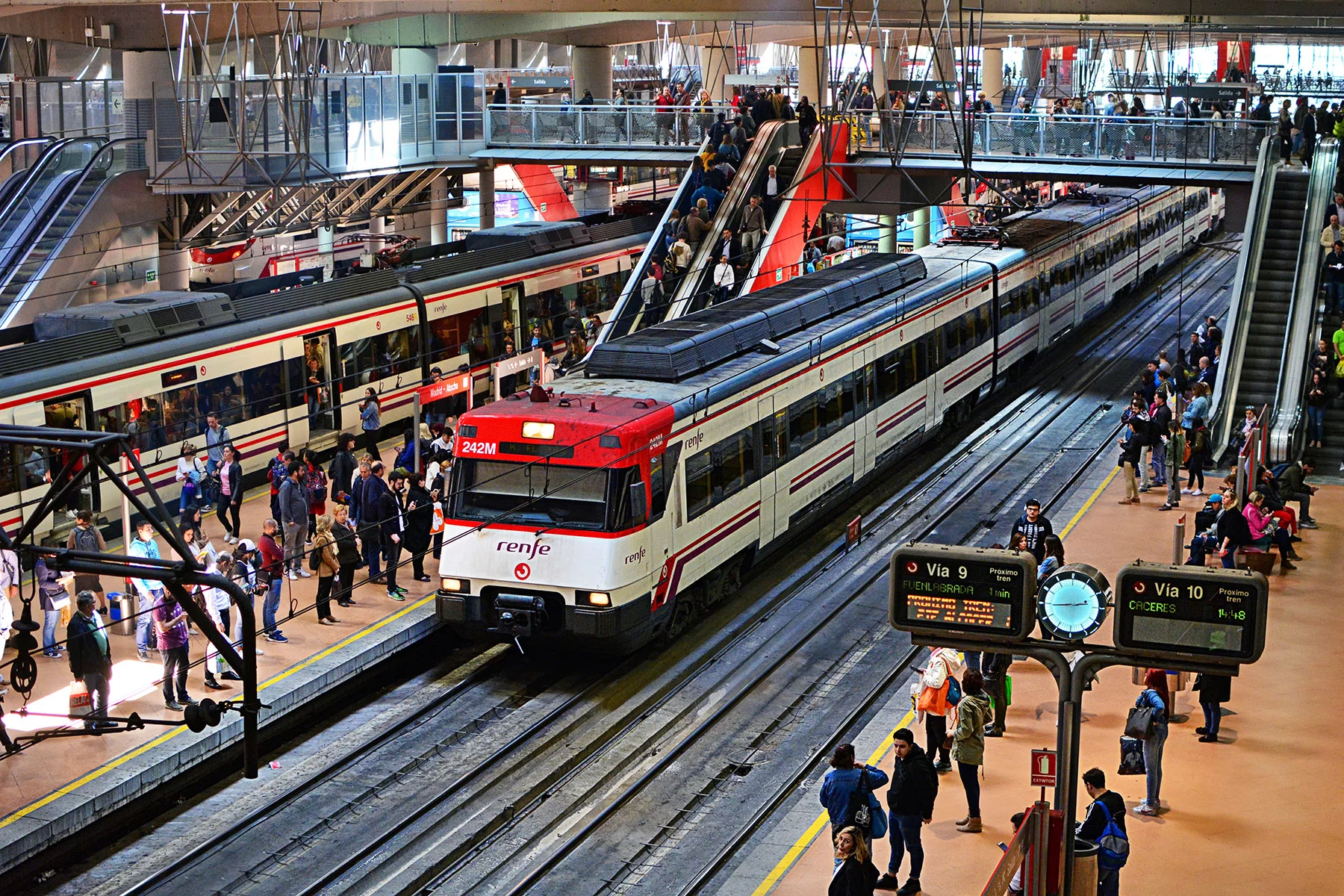
Three Spanish cities also have their own metro systems: Barcelona, Bilbao, and Madrid. Another 13 have trams, mostly running at street level:
- A Coruña: Tranvía Historico
- Alicante: Alicante TRAM
- Barcelona: Trambaix, Trambesòs, and Tramvia Blau
- Bilbao: Euskotren Tranbia
- Madrid: Metro Ligero
- Murcia: Tranvía de Murcia (in Spanish)
- Parla: Tranvía de Parla (in Spanish)
- Sevilla: MetroCentro
- Sóller: Tranvía de Sóller
- Tenerife: MetroTenerife
- València: Metrovalencia
- Vitoria-Gasteiz: Euskotren Tranbia
- Zaragoza: Tranvía Zaragoza
Ticket prices vary, as each metro and tram network is run by a local transportation authority. In most cities, a single fare over a shorter distance on the tram is around €1.20 to €1.50; single tickets on a metro network tend to be more, however, ranging between €1.50 and €2.50. Cities with larger networks may have additional costs based on distance or the number of zones you travel.
International trains in Spain
Due to the difference in gauge on Spanish train tracks, connections with neighboring countries have historically been limited. Renfe has been working to change that, however, with many high-speed services to France now in service.
Renfe collaborates with SNCF, France’s national railway company, to provide high-speed trains between France and Spain from Madrid and Barcelona to French cities such as Lyon, Marseille, Montpellier, Paris, and Toulouse. A high-speed train from Barcelona to Paris takes about 6.5 hours.
Rail connections between Spain and Portugal are few and far between, however. There is a daytime connection between the Galician city of Vigo and Porto. Connections to Hendaye and Madrid were permanently suspended during the COVID-19 pandemic.
Neighboring Andorra and Gibraltar have no railway networks of their own, so you’ll have to take the bus or drive to get there from Spain. Morocco, which borders the Spanish cities of Ceuta and Melilla, has a rail network of its own, but there are no train services connecting the two.
Buses in Spain
Spain doesn’t have a national bus company; rather, each municipality or urban area has its own local public transport authority with bus routes in the area. Networks can sometimes be difficult to decipher if you’re unfamiliar with the network. Some Spanish cities only have one bus company with a simple fare system; others have overarching agglomerations that oversee multiple companies on a network with fare zones. Larger urban areas in Spain tend to have a separate company offering interurban services that connect city centers with outlying areas.
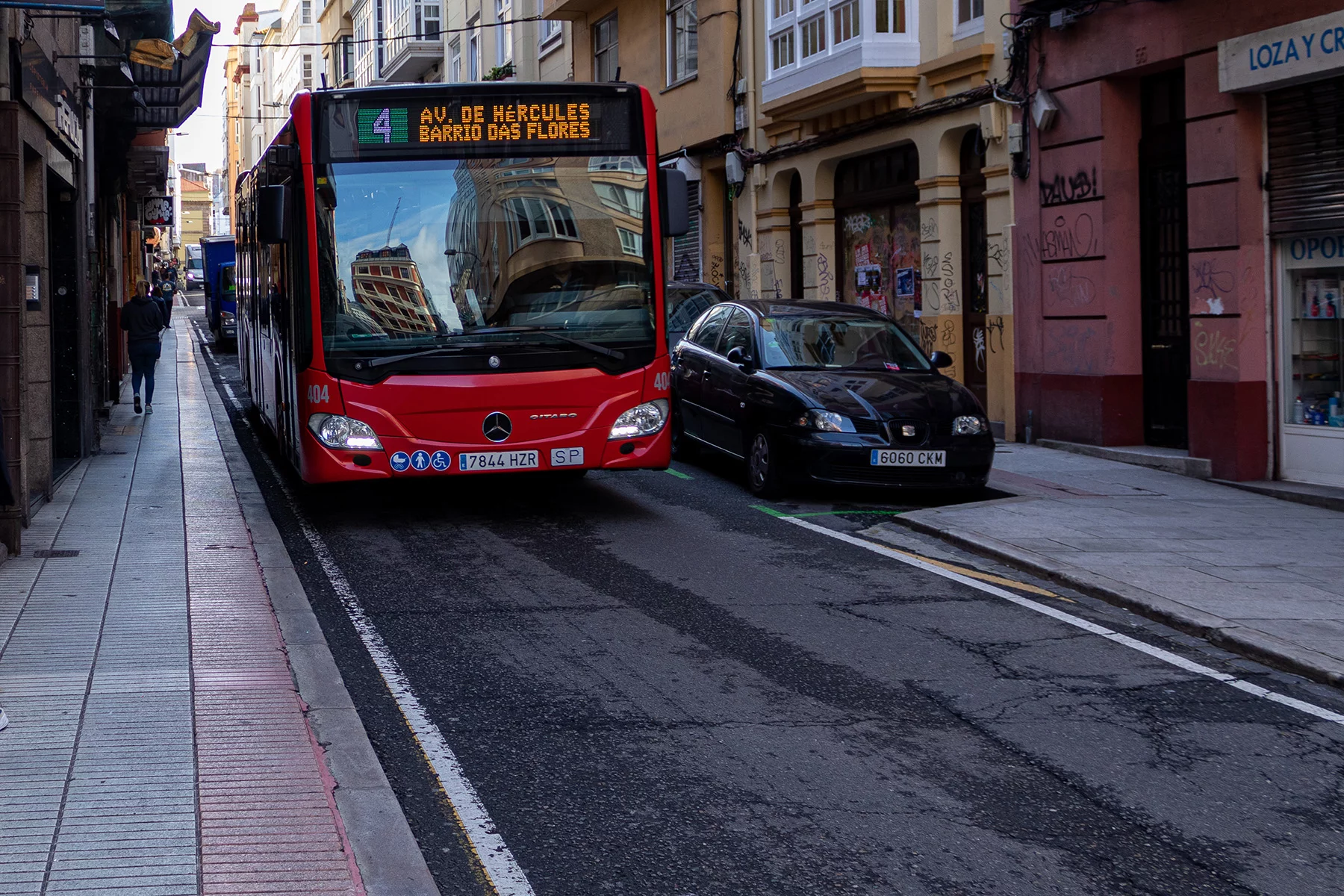
In general, it’s pretty clear who operates the bus you’re riding on. The main bus companies in some of Spain’s largest cities include:
- Barcelona: Transports Metropolitans de Barcelona (TMB)
- Bilbao: Bilbobus and BizkaiBus (in Spanish and Basque)
- Las Palmas de Gran Canaria: Guaguas Municipales
- Madrid: Empresa Municipal de Transportes de Madrid (EMT Madrid)
- Málaga: Consorico de Transporte Metropolitano del Área de Málaga (CTMAM)
- Murcia: Transportes de Murcia (in Spanish) and TMP Murcia (in Spanish)
- Palma: Empresa Municipal de Transportes de Palma de Mallorca (EMT Palma)
- Sevilla: Transportes Urbanos de Sevilla (TUSSAM)
- València: Empresa Municipal de Transportes de València (EMT València)
- Zaragoza: Consorcio de Transportes del Área de Zaragoza (CTAZ) (in Spanish)
For intercity bus routes, look for an estación de autobuses (literally, bus station); larger urban areas tend to have a single station where all long-distance public buses depart from, making connections a lot easier.
Bus tickets in Spain
In Spain, public transport by bus is operated locally, which means that bus fares vary from city to city. In general, a single ticket costs around €1.40 to €1.60, though some cities (such as Barcelona) charge over €2 for a ticket.
Some public transport companies in Spain offer special tickets for a certain number of trips (e.g., a 10-trip ticket) or time period (e.g., a 24-hour ticket). Many operators also offer contactless travel cards instead of paper tickets, which you can load a subscription or special ticket onto.
There is no national travel card in Spain, unfortunately; check with your local operator to see what’s available for your city or region.
Taxis and ride-sharing services in Spain
Public transport in Spain is quite affordable and reasonably efficient in most cities. For journeys that need it, Spanish cities are swarming with taxicabs. Each city in Spain has its own companies, so you might notice that taxis look completely different in Madrid (where the front door has a diagonal red stripe) and Barcelona (where the taxi livery is a bold combination of black and yellow).
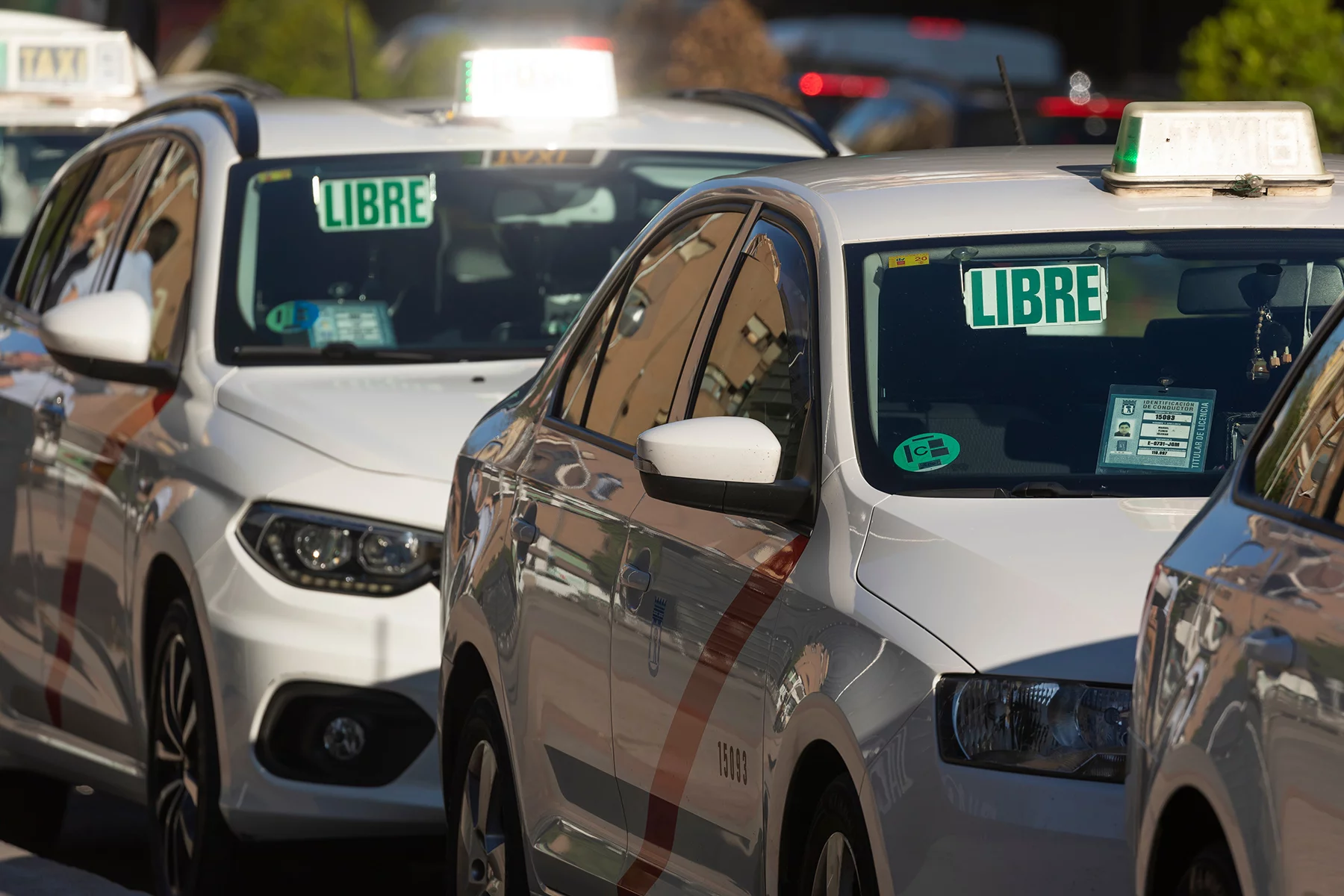
Taxis are widely available in all Spanish cities. Taxi ranks are available at major transportation hubs; elsewhere, it’s fairly easy to flag a taxi down from the street. Payment by cash is easiest, though some cities like Madrid ensure that all taxis also accept credit cards. Fares vary by city and taxi company; in general, expect a base fare (inicio de servicio) of around €2–3 and per kilometer charges (precio por kilómetro) around €1–2 per kilometer.
Hailing a taxi with an app is also possible in most Spanish cities. A few of the more prevalent taxi apps in Spain include:
Ride-hailing apps like Uber have been embroiled in heated debates, with massive taxi driver strikes sometimes bringing the streets of Madrid and Barcelona to a standstill. Still, Uber is available in Spain and operates in some fashion in many Spanish cities. Taxi rides are also available through Uber in select cities.
Long-distance coaches in Spain
Despite Spain’s extensive railway network, many cities don’t actually have a train station of their own. As a result, long-distance intercity bus services are quite popular in Spain, especially for those in search of better prices.
Bus operators in Spain need to acquire a license to drive specific routes. For the traveler, that means there are often only a couple of options to choose from, far fewer than in other countries where the competition is more fierce. However, the benefit here is that Spanish authorities can guarantee bus service on a route and that a company can’t just abandon it if they’re not profitable.
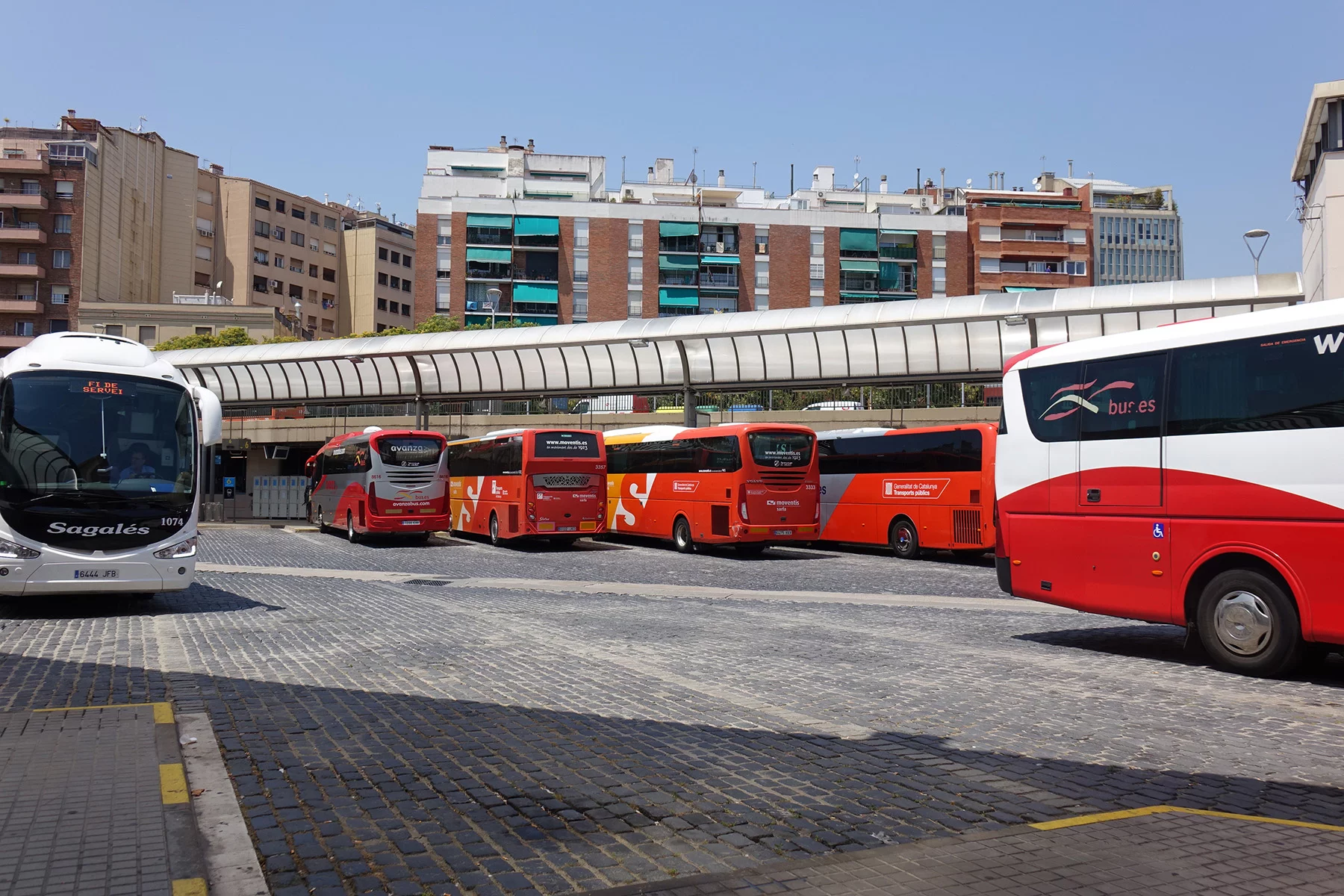
The two largest long-distance bus companies in Spain are Alsa and Avanza (in Spanish). These two companies have route networks that cover all of Peninsular Spain as well as some routes extending into neighboring countries. Other more prominent bus companies with routes in Spain include Comes, Hife, Daibus, Damas (in Spanish), and InterBus.
Tickets are available either at the bus station, on the bus itself, or through the operator’s website. If you’re not sure which company to book through, you can try looking up the route with a route-planning website like Rome2Rio or Movelia. Booking platform Omio can also help you to find the best options.
It’s also possible to travel internationally by coach from Spain. Companies such as Flixbus, Alsa, and BlaBlaBus offer direct connections to Portugal, France, Italy, and more.
On-board, expect cleanliness and comfort. Long-distance buses are modern coaches with toilets, Wi-Fi, and even beverages for purchase. Services depend on the company, though; smaller operators may not have the same on-board facilities as the larger ones.
Airports in Spain
Spain isn’t tiny; it’s the second-largest country in the European Union, in fact. As a result, there are plenty of ways to get around, including by air. While Spain’s robust high-speed rail network is making inroads, flying remains a popular option for domestic travel.
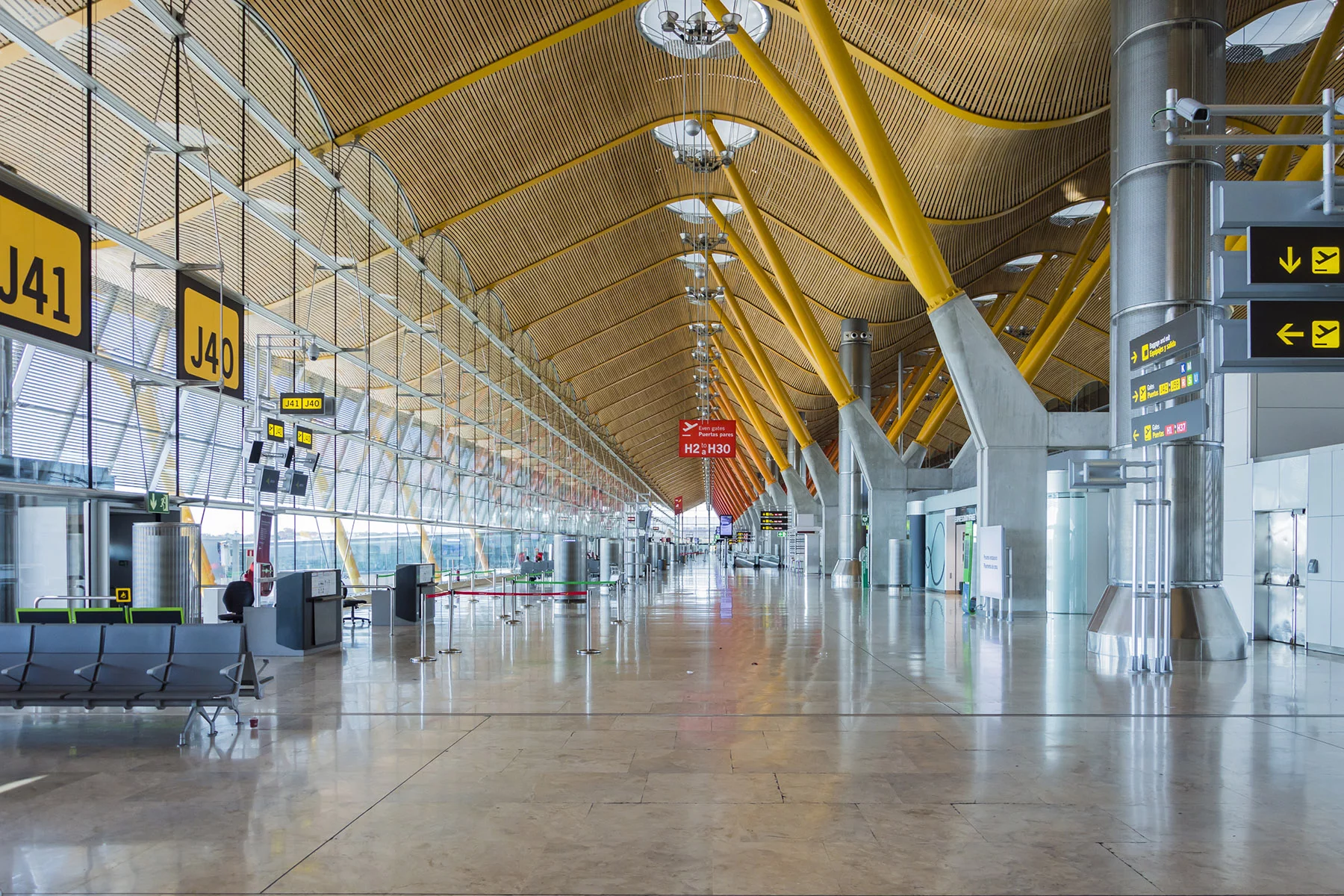
The largest airlines flying domestic routes within Spain are Iberia (Spain’s flag carrier), Air Europa, Volotea, and Vueling.
Adolfo Suárez Madrid-Barajas Airport
Spain’s largest airport is Aldofo Suárez Madrid-Barajas, which is operated by Aena. It serves the Madrid metropolitan area and is about 13 kilometers from the city center. It’s the primary hub for Iberia and handled 24 million passengers in 2021 (down from around 62 million in 2019). It has hundreds of destinations including cities in Europe, Africa, Asia, North America, and South America. There are also plenty of facilities in its five terminals, including shops, restaurants, and assistance for people with reduced mobility.
To reach the airport by public transport, you have several options:
- Metro: Line 8 from Nuevos Ministerios
- Train: Two commuter lines stop at Terminal 4 – Line C1 from Príncipe Pío and C10 from Villalba. Both also stop at Madrid Atocha.
- Local buses: The Airport Express Line 203 connects Atocha railway station with the airport, line 101 departs from Canillas, while line 200 goes from the Avenida de América Interchange.
- Intercity buses: Lines 822, 824, 827, and 828 travel between the airport and outlying areas of Madrid.
- Long-distance coaches: Alsa, Sociobus, and Avanzabus run services to the airport from other cities in Spain.
As the airport is one of Europe’s largest, make sure you know which terminal your flight departs from and get there in plenty of time. If you need to transfer between terminals, you can use the free transit buses which depart every 8–10 minutes (every 40 minutes from 01:30–05:30).
Barcelona-El Prat Airport
Barcelona-El Prat Airport is Spain’s next busiest. It’s located about 15 kilometers from Barcelona and is a hub for Level and Vueling. Although it only has two terminals, it still offers hundreds of routes to global destinations.
The airport is reachable by metro, bus, and train. L9 metro line stops at both terminals. You can reach terminal 2 with the R and R2 train lines, and multiple bus routes also serve the airport. A shuttle service goes between terminals every 7–20 minutes.
Palma de Mallorca Airport
Spain’s third busiest airport, Palma de Mallorca, is located near the village of Can Pastilla. It is Mallorca’s only commercial airport, and its flights cover most of Europe. To get to the airport, you’ll need to drive, take a taxi, or catch a bus. Two intercity routes, A32 and A42, stop at the airport, as well as the A1 and A2 city buses.
Málaga-Costa del Sol Airport
Málaga airport is an essential airport for tourism in Spain. Most of its flights go to elsewhere in Spain and Europe, as well as some Middle Eastern and North African destinations. You can reach the airport with long-distance, intercity, and local buses, or catch the C1 train from Málaga itself.
Other methods of public transport in Spain
If you want to travel to some of the Spanish islands, a great way to do this is by ferry. There are several private ferry companies operating in Spain with routes from mainland Spain to the Balearic Islands, the Canary Islands, Ceuta, Melilla, and more. Spain also has several ferry links with other countries, including France, Morocco, and the UK. While traveling this way takes a lot longer than flying (Barcelona to Mallorca is a 5-8 hour journey), it’s one way to save money and make your trip more sustainable.
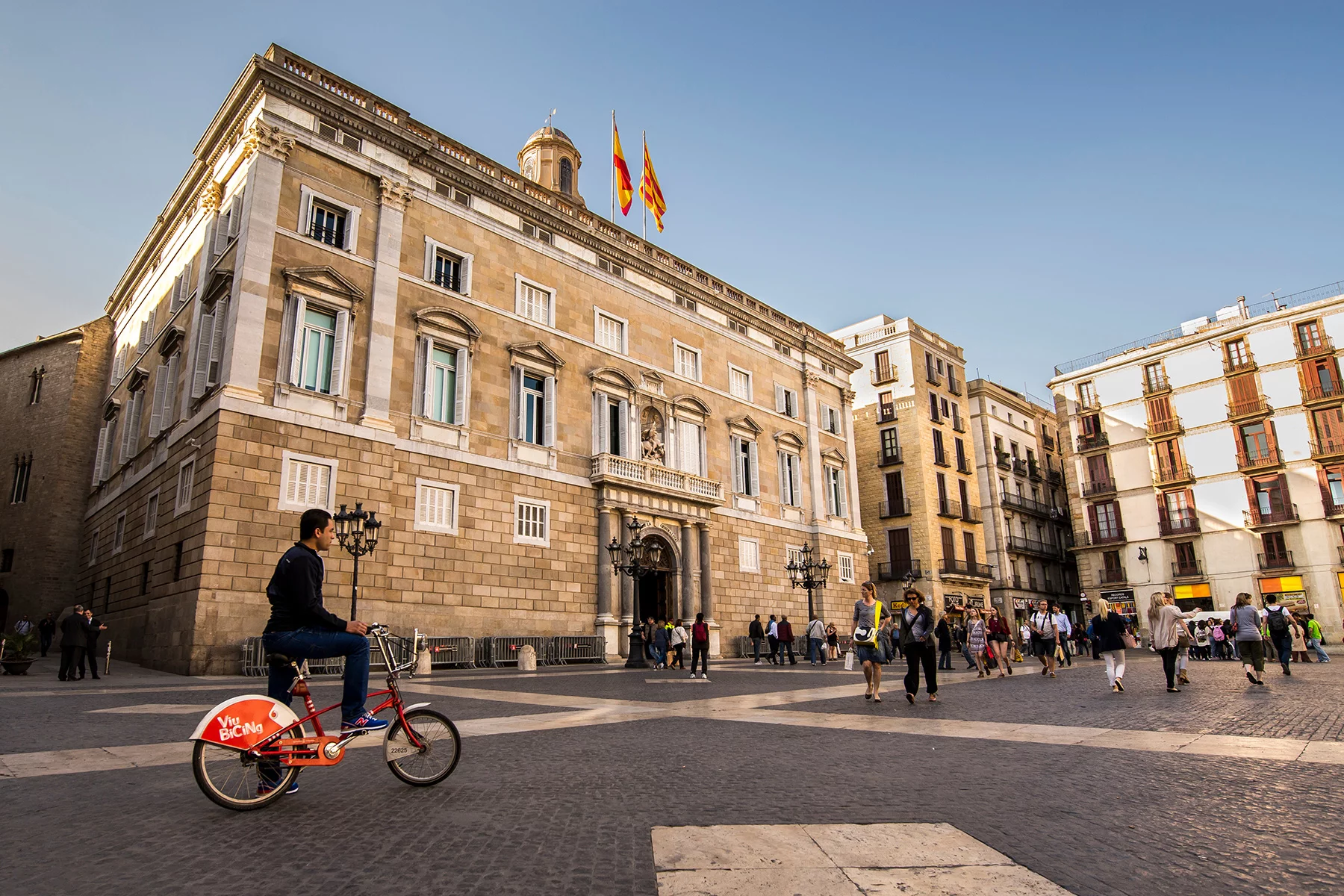
Another sustainable (and fun!) way to get around is by bike. To make it even easier, some cities have bicycle-sharing schemes. For example, BiciMAD (in Spanish) in Madrid allows you to hire an electric bike for €2 for the first hour, and €4 thereafter. Barcelona’s Bicing (in Spanish) offers both standard bikes and electric bikes to explore the city on, costing just €0.35–€0.55 for the first half hour.
Public transport discounts in Spain
Renfe offers reduced ticket prices for certain groups, including the following:
- Infants under 4: All infants travel for free if they don’t occupy their own seat. However, passengers must still reserve a (free) ticket for their baby.
- Children under 14: Children sitting in their own seat receive a 40% discount on the normal ticket price.
- Youth between 14 and 25: Young people can buy a +Renfe Joven 50 Card for €50, which offers discounts ranging between 30–50% on long-distance and high-speed services and 25% on mid-distance trips. Higher discount levels are possible the further in advance you reserve. The +Renfe Joven 50 Card is valid for one year.
- Seniors over 60 and disabled travelers: Renfe doesn’t offer discounts for individual tickets for the elderly and the disabled. Rather, seniors can buy a Tarjeta Dorada (Gold Card) for €6. The Tarjeta Dorada is valid for one year and offers discounts of either 25% or 40%, depending on the service and the day of travel.
- Large families: Discounts are also possible on fares if you are part of a large family. Discount rates range between 20% and 50%.
Urban public transport companies in Spain also have plenty of discount tickets or subscriptions for certain groups. These often include discounts for young children, young adults, senior citizens, large families, and those with a disability. Regulations and discounts vary from city to city in Spain, however, so check with your local public transport authority.
How disability-accessible is public transportation in Spain?
Spain is hardly a world leader when it comes to accessibility in public transport, unfortunately. Spanish law actually began paying attention to how inaccessibility to public spaces is a form of discrimination back in the 1980s, not long after Spain’s transition to democracy. However, accessibility improvements to things such as public transport vary across the country.
Most metro systems and tram networks in Spain mostly date back to the 1990s at the earliest; vehicle interiors are accommodating to wheelchair users and platforms are generally accessible by elevator. One key exception to this is the Madrid Metro, which is the oldest metro network in Spain. Here, three of the older lines (Lines 1, 2, and 4) are particularly poor when it comes to accessibility at the station; more recent parts of the network are fully accessible.

Accessibility at Spanish train stations varies depending on the size of the station. Some train stations have undergone major renovations in recent years and, as a result, are fully accessible at all platforms. Older stations in less central areas may have outdated facilities for disabled travelers; some platforms may actually be inaccessible. Renfe’s Atendo service also in-station guidance and assistance for those with limited mobility.
If you plan on taking a taxi, call the taxi company directly and ask for a taxi adapted for wheelchairs.
Some tourism boards also provide ample information about accessible mobility in English, including Barcelona and Madrid; even if you live in Spain permanently, many of the tips for getting around apply just the same.
How environmentally friendly is public transportation in Spain?
Authorities in Spain are struggling to boost the green credentials of local public transport in the country. There is evidence that new developments tend to focus on the needs of Spain’s massive tourism sector rather than local mobility needs. Indeed, the Spanish approach often opts for marginal improvements to bus routes while neglecting the need to get cars off the streets or improving infrastructure for cyclists and pedestrians. Madrid’s ambitious plan to restrict vehicles in the city center was struck down by Spanish courts in July 2020 despite being lauded across Europe for its’ efficacy in reducing car emissions.
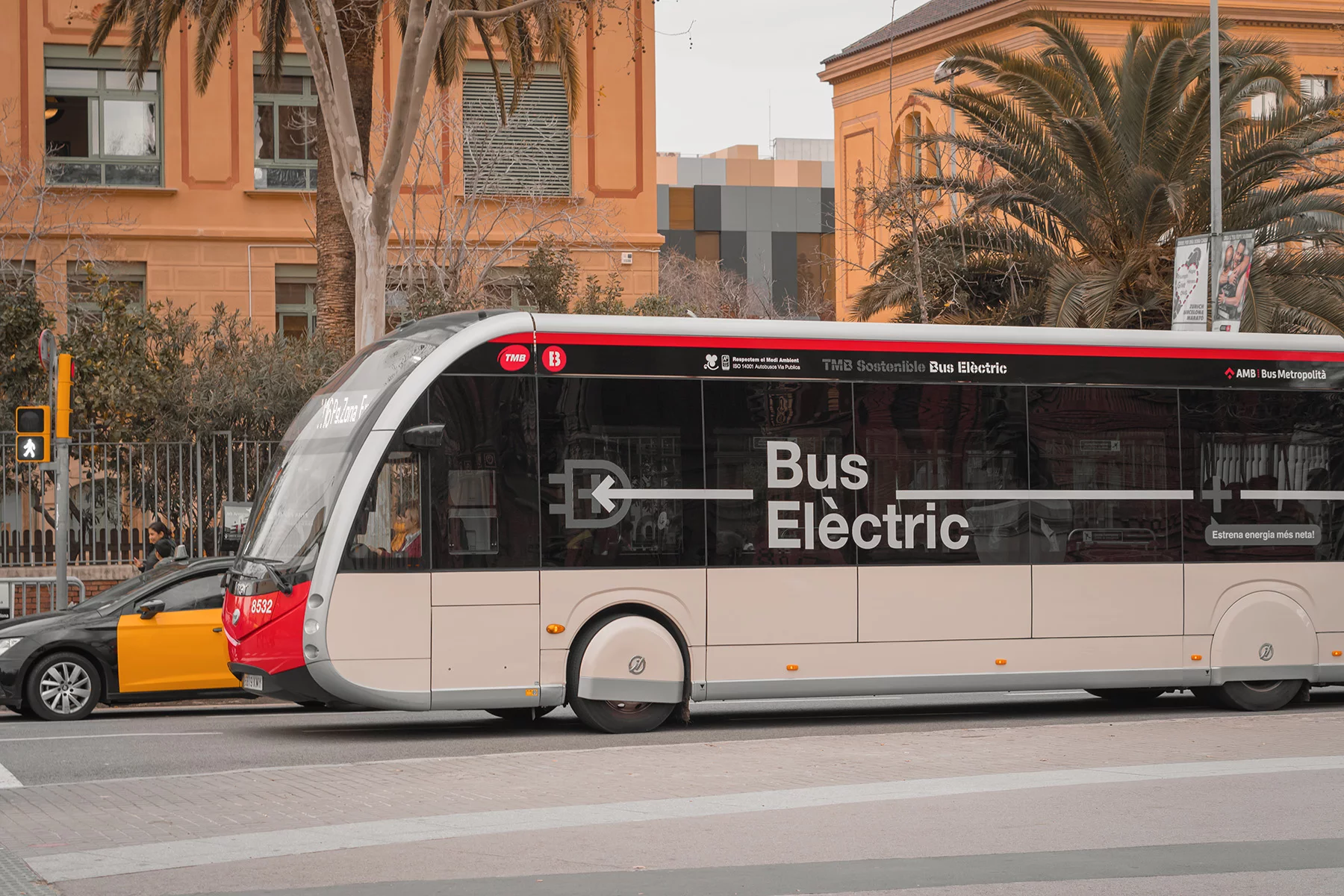
Nonetheless, progress continues in some Spanish cities. Barcelona rolled out its own low-emission zone in 2020, while cities like Bilbao and Madrid are gradually integrating electric buses into their local fleets. Another glimmer of hope comes in the form of the Ley de Movilidad Sostenible (Sustainable Mobility Law), a draft law which aims to provide better transport across the country and finding ways to make it sustainable and more accessible.
Making a public transport complaint in Spain
As with many countries, there is no central authority for filing a complaint relating to an incident. Any public transport issues in Spain worthy of filing a complaint should go directly to the company itself.
Renfe has an online contact form which you can use to address more common issues relating to train travel. There are also some conditions where train delays are eligible for compensation from Renfe.
Useful resources
- EMT Madrid – public transport in Madrid
- EMT València – public transport in València
- Renfe – Spain’s national railway operator
- TMB Barcelona – public transport in Barcelona
- TUSSAM – public transport in Sevilla
